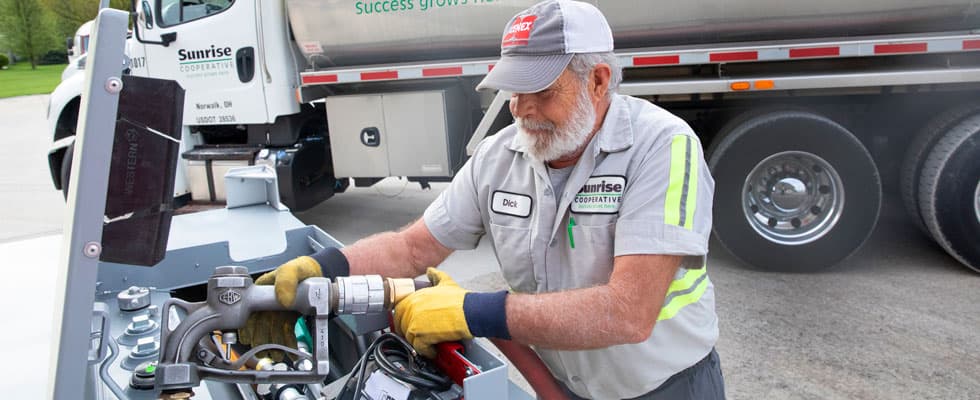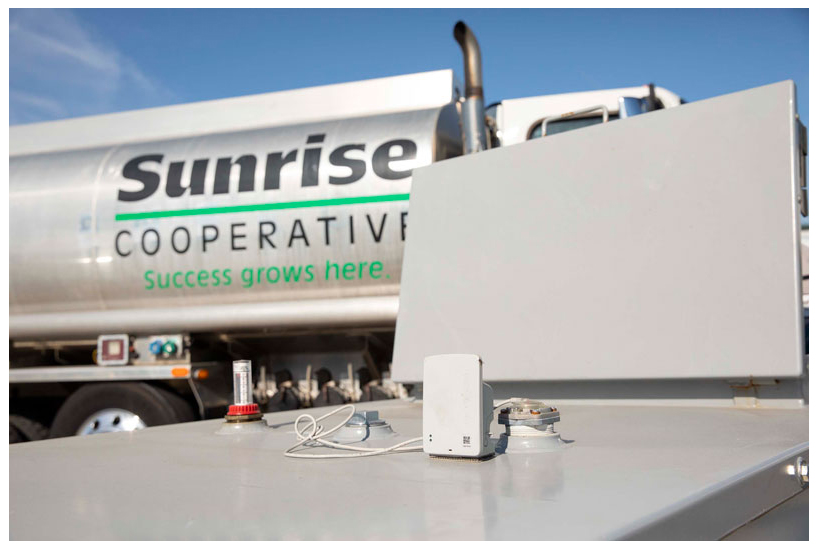
Dick Schaffer has been delivering fuels for Sunrise Cooperative for 40 years and, like many delivery drivers, he knows his route inside and out. While he looks forward to retiring soon, he was not too happy three years ago when he heard that remote tank monitors were being installed on his route.
He said it felt like management did not trust him or that maybe they were out to cut back on his volume of work. As a senior and well-respected driver, Schaffer’s opinion carries a lot of weight at Sunrise.
Gone Fishing
A year into Sunrise implementing the remote tank monitoring program, though, Schaffer came to his boss, Vice President of Energy Jason Kamann, at 2 p.m. on a Friday afternoon to let him know he was leaving early for the day to take his grandson fishing. Both Schaffer and Kamann knew from the remote tank monitor information the company now had access to that every customer on his route was all set for the weekend.
Having seen the benefits of remote tank monitoring on reducing driver stress, improving the company’s operational efficiency and increasing his customers’ satisfaction, Schaffer had become an unexpected champion of industrial IoT (IIoT), which, at Sunrise Cooperative, took the form of remote tank monitoring. Schaffer told Kamann he wished they had brought in the monitoring program decades ago, because then he would have been able to take his own son fishing.
The Decision to Monitor Tanks
Sunrise Cooperative is an agricultural and energy cooperative based in Ohio and 100% farmer owned. The co-op serves an extensive client base with propane, petroleum, lubricants and diesel exhaust fuel products. Three years ago, Sunrise Cooperative made the decision to bring in monitoring solutions from Bergquist and Anova to help it transform its fuel distribution business.
Imagine having one of your most senior propane delivery drivers, like Schaffer, drive around making 20 stops a day for 200 straight days and not delivering a single drop of propane. That would be 4,000 trips Schaffer did not need to make. Sunrise Cooperative unearthed this and other hidden inefficiencies in their traditional operations after utilizing Anova Transform. Using a combination of industry expertise and analytical software applied to a client’s historical delivery practices, the solution reveals actionable insights and drives greater distribution profitability with each cycle.
 Pushing Through Old Boundaries
Pushing Through Old Boundaries
Since implementation of the remote tank monitoring tool, Kamann has become an outspoken leader on the combined benefits of remote tank monitoring with deep transformative assessment and analysis.
“From making that first decision to use remote tank monitoring, to starting our journey with the service, we have pushed through so many boundaries, identifying problem tanks, knowing exactly where to place the tank monitors and when to upsize a client’s tank, to being able to save on supply costs with a better understanding of our inventory,” he said.
By the Numbers
By monitoring tanks and acting on the insights they provided, Sunrise Cooperative was able to achieve 50% fewer excess fills with fewer deliver stops, increasing profits. Their average fill rate increased significantly from 39% to 57% on monitored tanks. Customer service improved, with 3.5 times fewer out-of-gas events. Operations became more profitable with 50% fewer early drops and two times fewer zero-gallon drops.
Beyond these core efficiency improvements, Sunrise Cooperative also identified multiple, sometimes unexpected, benefits of using the monitoring program.
“Aside from the fill rate improvements, we also know when competitors were topping off our customers — the tank data shows us that levels increase but we had not made a recent delivery.
Having detailed monitor data also provides us proof that our deliveries were made to our customers. If there is a storm, we know exactly which clients need gas, allowing us to reduce risk to our drivers and focus on those customers most in need,” said Kamann. “Being able to see exact inventory across our own and our client tanks enables us to manage supply costs and to take advantage of price savings. Finally, we are better able to distribute deliveries, shaving the peak for our busy winter months.”
Picking the Right Partners and Champions
According to Kamann, innovation and service matter most for any solution. “Anyone can throw you a low-cost monitor, but innovation and service matter most. Our partners have proven that they deliver that, time and again,” he said. “Our biggest hurdle was getting our people to buy in, to trust the monitor, and don’t go early or run a stop just because it’s next door. Our biggest win was having Schaffer on board. You must pick one person who is respected, get them on board, and show them the numbers. It’s not management-controlled. It’s a partnership between management and the drivers and doing what is right for the company and the customer”
What to Look for in a Tank Monitoring Solution
- A true partner — Look for a partner with the experience and real industry expertise required to help you transform your business long term.
- A focus on innovation — Look for a partner that invests in delivering advances in technology and a track record of providing unique, transformative services for the industry.
- Trusted, reliable solutions — Look for a proven track record of reliability and robustness in the field. Seek solutions that will also grow with you, with multi-tank monitors and the ability to utilize the strongest communication signal in the field, on the fly.
- Flexible business models — Look for flexibility. More companies are getting started or expanding their tank monitoring programs with the hardware-as-a-service approach. You can monitor more, faster, with a monthly subscription service and no capital outlay.


